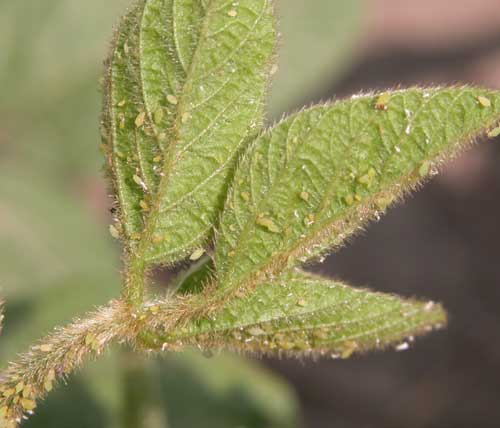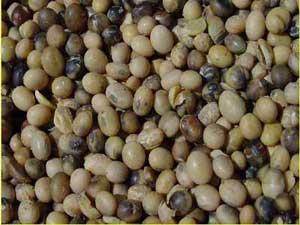
The mosaic pattern in these soybean leaves is due to infection by Bean pod mottle virus. Photo credit: Palle Pederson,.
Viruses are submicroscopic particles of DNA or RNA that cause disease in plants. They are different from other pathogens in that they can grow and reproduce only inside living cells.
Virus-like symptoms have been increasing in Wisconsin soybean fields in recent years, a trend confirmed by researchers in other Midwestern states. Mottled, crinkled leaves during periods of rapid growth, mottled seed, and lower than expected yields can be possible signs of virus infection.
Bean pod mosaic virus, Soybean mosaic virus, Alfalfa mosaic virus, and Tobacco streak virus are the viruses most commonly found in virus-infected plants. To make things more complicated, two or more soybean viruses are often found in the same plant. Multiple infections pose the greatest risk of reduced yield and grain quality.
Each virus is part of a plant-virus-insect complex
Viruses are spread from plant to plant by insects. Every virus is part of a unique plant-insect-virus relationship. Recognizing the virus as part of a complex is the key to effective management.
The insects that most commonly transmit viruses in soybean are bean leaf beetle (Cerotoma trifurcata), the soybean aphid (Aphis glycines) and other migratory aphid species, and thrips.

The soybean aphid is able to transmit several soybean viruses in Wisconsin. The bean leaf beetle is another common virus vector.
How to recognize a virus problem
Look for the following signs:
- Moderate to high insect activity
- Lower than expected yields
- Mottled seed
- No yield response to insecticides applied for soybean aphid control
- Presence of mottled, crinkled leaf symptoms typical of virus infection.
Virus Symptoms
Viruse infections are difficult to diagnose. Different viruses can cause similar symptoms, and infection by more than one virus is common.
Most virus-infected plants have fewer pods and are stunted to some degree. Pods may be flatter and smaller. Virus-infected leaves may be distorted, or wrinkled, or develop a mosaic or mottled pattern of dark green/light green/yellow patches. Leaf symptoms are most apparent during times of rapid growth and cooler weather. Be aware, however, that mottled and crinkled leaves can also be caused by herbicide injury or nutrient deficiencies.

Insect feeding and physiological stresses can also cause seed mottle. Fewer seed, shriveled seed, and feeding scars caused by bean leaf beetle can be seen on this seed.
Mottled seed
Seed coat mottling is a symptom associated with virus-infected plants, including Bean pod mottle virus and Soybean mosaic virus.
Seed coat mottling occurs when pigments diffuse from the seed hilum. Some seed are entirely black or brown, but bicolored seed are more common. Hilum color will determine the color and intensity of seed coat discoloration. Mottled seeds are an issue for grain grading, especially for food-grade soybeans. Mottling is associated with poor germination and yield.
All mottled seed is not caused by virus, however. Insect feeding and physiological stresses can also cause seed mottle. Sometimes virus-infected seed does not show mottling symptoms. Therefore seed mottling is not a good predictor of virus infection.
Managing Soybean Viruses
|
Virus |
Epidemiology |
Control |
|
Soybean mosaic virus (SMV) |
SMV is introduced into soybean fields with infected seed. Aphids feed on infected plants and transmit SMV to healthy plants season-long. |
Plant SMV-free seed. Variety resistance reported, but commercial varieties are not rated for reaction to SMV. Plant early to avoid aphid vectors. |
|
Bean pod mottle virus (BPMV) |
BPMV acquired by beetles from legume hosts and introduced into soybean fields. Transmission occurs season-long. Infected seed is a minor source of inoculum. BPMV survives in bean leaf beetle over the winter. |
Varieties differ in incidence of infected plants and yield in the presence of BPMV. Avoid early planting dates. Where populations are high, control early season beetles with insecticides to reduce virus transmission.
|
|
Tobacco streak virus (TSV) |
Most TSV inoculum is introduced into soybean fields with seed. Thrips transmit from plant to plant during growing season. |
Plant TSV-free seed. |
|
Alfalfa mosaic virus |
Most AMV is introduced into soybean fields by insect vectors that acquire the virus from forage legumes. Transmission occurs season-long. |
Resistant varieties have not been reported. Plant early to avoid aphid vectors. |


